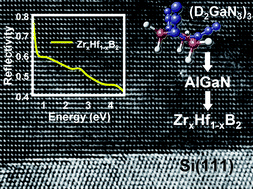Synthesis of (Hf, Zr)B2-based heterostructures: hybrid substrate systems for low temperature Al–Ga–N integration with Si
Abstract
A hybrid substrate technology based on nearly lattice matched GaN/ZrB2-buffered Si(111) was utilized to grow AlxGa1−xN heterostructures via a new method involving displacement reactions of D2GaN3 vapors and Al atomic beams at unprecedented low temperatures of 650–700 °C, compatible with Si-processing conditions. Homogeneous films exhibited strong cathodoluminescence with narrow peak widths comparable to those observed in


 Please wait while we load your content...
Please wait while we load your content...